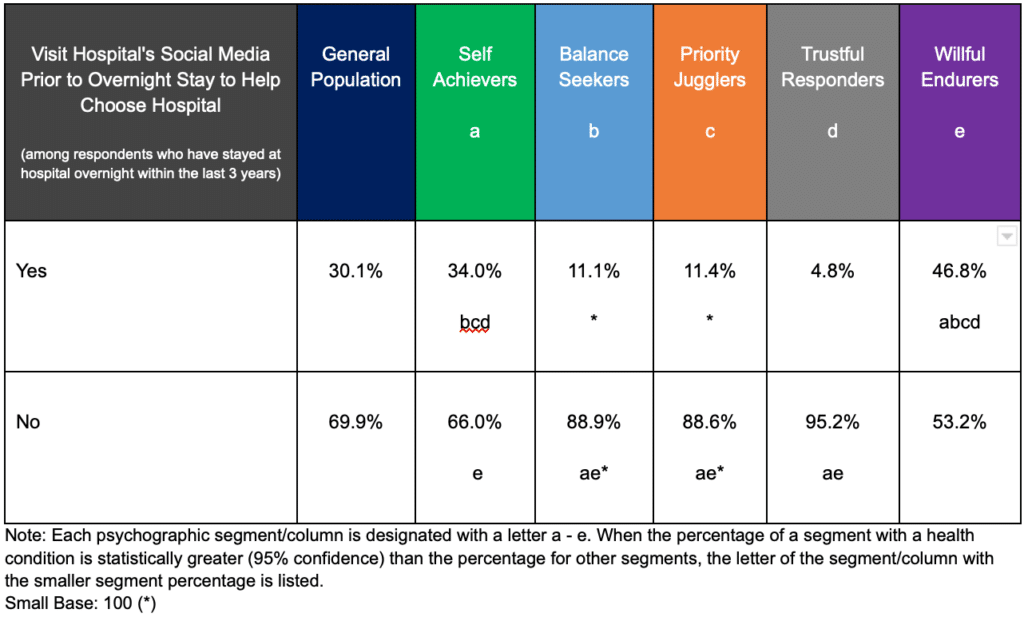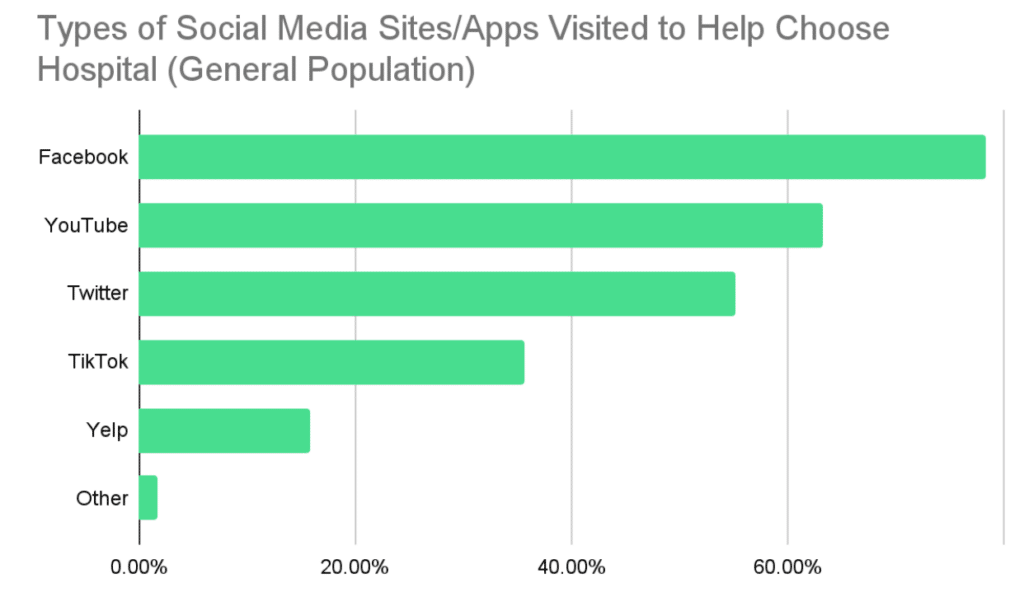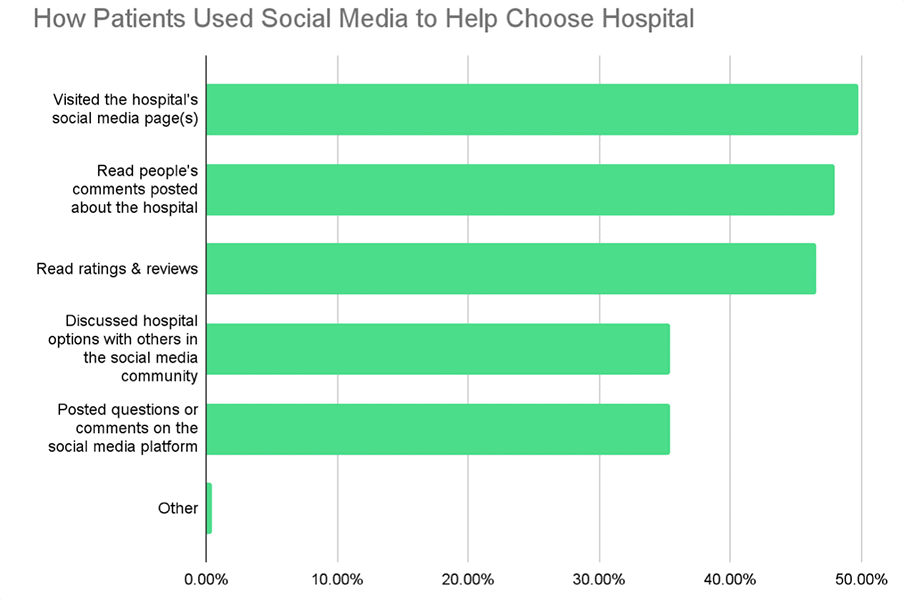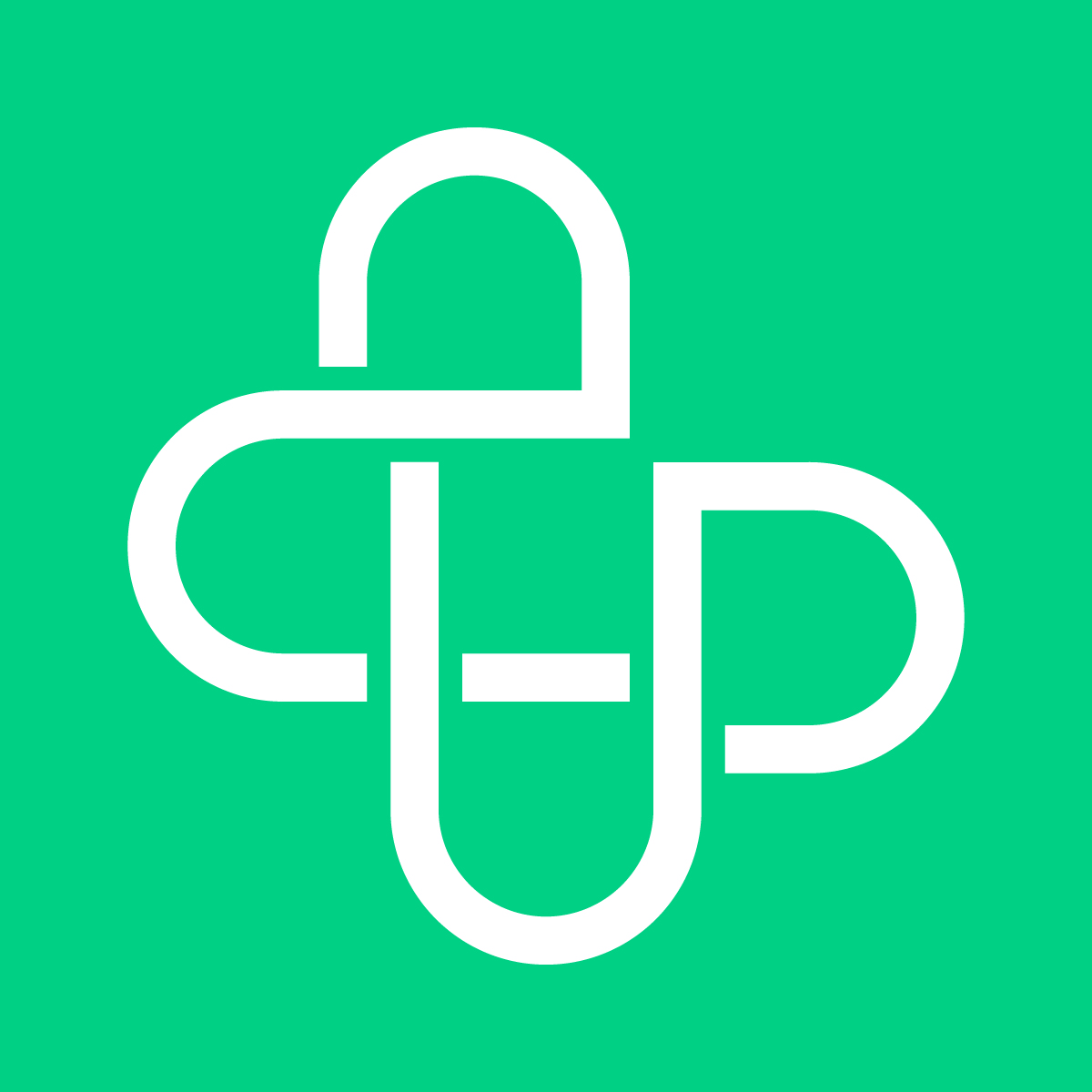Social media has become a big part of the research patients do to choose their hospital, and patient experience lies at the center of it. It’s not unusual for relatives and friends to openly share their experiences (good and bad) on Facebook. Some progressive health systems are even partnering with influencers on TikTok. Each of these touchpoints factor into their decision on why they choose a hospital. Social media has become the 21st century’s Word of Mouth.
To get a better understanding of this, here’s a close look at a recent Upfront market research study data that shows how healthcare consumers use social media to determine their hospital choice.
Patients look at social media before choosing their overnight hospital stay.
Upfront market research found that among patients who have received care at hospitals within the last 3 years, 30.1% of the general population referred to social media. However, there are segments of healthcare consumers who are much more likely to use social media to inform their choice of hospitals.
Upfront uses its proprietary psychographic segmentation model in addition to other data analytics to deeply understand healthcare consumers’ behaviors. Psychographics pertain to people’s attitudes, values, beliefs and personalities and are core to their motivations, priorities and communication preferences. Upfront has identified five distinct psychographic segments, each with different approaches to health & wellness and unique engagement preferences:
- Self Achievers: The most proactive segment, willing to invest in their health and striving for constant improvement. Goal oriented and most likely to pursue preventive care,
- Balance Seekers: Wellness-oriented though independent. Balance Seekers follow good nutritional and exercise habits but do not engage the healthcare system as often as other segments. They want options so they can choose their care path.
- Priority Jugglers: Dedicated to family and work, Priority Jugglers will often sacrifice their own wellness to ensure their loved ones get all the care they need. Focused on many responsibilities, they are challenged to find time in their busy schedules to take care of themselves.
- Trustful Responders: Reactive in healthcare though higher utilizers of the healthcare system, Trustful Responders want directive guidance from physicians and other healthcare professionals. They will typically follow clinicians’ recommendations and referrals if they can fit it into their daily routines
- Willful Endurers: The most reactive segment and often disengaged from healthcare, Willful Endurers live in the moment and want immediate benefits and gratification. Independent and self-reliant, they may avoid medical care until it is absolutely necessary.
Looking at a patient population this way uncovers some provocative insights.

Among psychographic segments, nearly half of Willful Endurers used social media to help them choose a hospital, and this segment is statistically the most likely to do so. A third of Self Achievers used social media to inform their decision, statistically more likely than three other segments. Considering these two segments (out of the five healthcare consumer segments) make up more than half of healthcare consumers, this is a notable statistic.
Facebook, YouTube and Twitter are the most popular social media channels to visit when choosing a hospital.
It’s no surprise that the most prominent social channels are among the most popular among healthcare consumers when choosing a hospital. Among healthcare consumers who used social media to choose a hospital, Facebook is used the most at 78.3% followed by YouTube at 63.2% and Twitter at 55.2%. However, TikTok is becoming a popular space for healthcare consumers to visit and 35.7% of the population uses it to help choose a hospital. Among psychographic segments, 50% of Priority Jugglers use it followed by 39.8% of Willful Endurers anf 27.9% of Self Achievers.

On average, healthcare consumers looked at 2.5 social media sites before choosing a hospital, which shows how important it is for providers to have a strong social presence on all of their social channels. It’s not unusual for any organization to be lax on their engagement on certain social media channels and focus more heavily on others. But the reality is that patients may look at some that aren’t as robust (e.g., not responding to comments or reviews, posting rarely, etc.) and judge the hospital accordingly..
Patients use social media in several ways to help choose a hospital.
Not every patient looks at social media before choosing a hospital, but for those that do, how do they use it?
When Upfront asked this question to healthcare consumers, the most popular answer is that they visit the hospital’s social media pages to read the hospital’s posts (49.8%), but that’s closely followed by reading people’s comments posted about the hospital (48%) and reading ratings and reviews (46.6%).

On average, patients engaged in more than two of these activities, many of which encompass patient experience from different angles. Patients are pursuing several avenues to get the best I information possible to determine their choice because they know there are opinions and recommendations everywhere. Every patient’s experience is unique, but a reoccuring theme of a good or bad experience can give healthcare consumers the best idea of what will be best for them.
The way patients choose their hospital provider is much more nuanced than it used to be thanks to social media. In our next blog, we’ll go over social media strategies hospitals can use to acquire more patients based on these trends.
In the meantime, watch our on-demand webinar, Personalize Marketing and Patient Engagement Like World Leading Retailers, to learn more about how patients choose their hospital provider.



